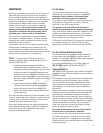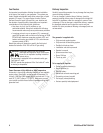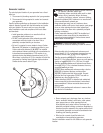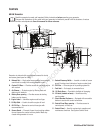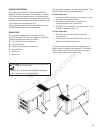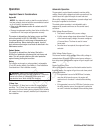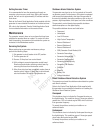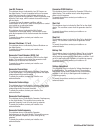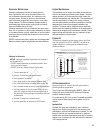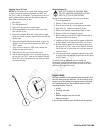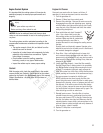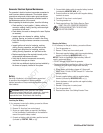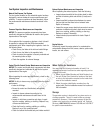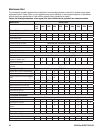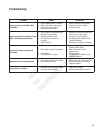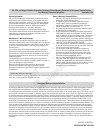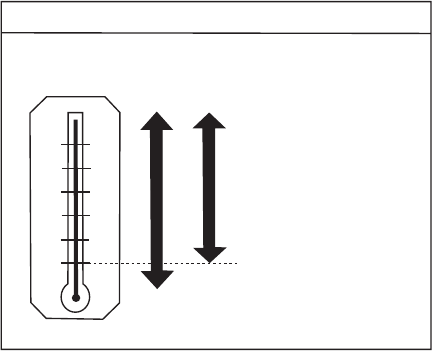
15
Generator Maintenance
Generator maintenance consists of keeping the unit
clean. Operate the unit in an environment where it will
not be exposed to excessive dust, dirt, moisture or any
corrosive vapors. Cooling air louvers on the enclosure
must not become clogged with snow, leaves, or any other
foreign material. To prevent generator damage caused by
overheating, keep the enclosure cooling inlets and outlets
clean and unobstructed at all times.
Check the cleanliness of the unit frequently and clean when
dust, dirt, oil, moisture or other foreign substances are visible
on its exterior/interior surface. Inspect the air inlet and outlet
openings inside and outside the enclosure to ensure air flow
is not blocked.
DO NOT use direct spray from a garden hose to clean generator.
Water can enter the engine and generator and cause problems.
Cleaning the Generator
1. Turn the generator off.
2. Remove 15 Amp fuse from control board.
3. Clean generator as desired.
• Use a damp cloth to wipe exterior surfaces clean.
• Use a soft, bristle brush to loosen caked on dirt, etc.
• Use a vacuum cleaner to pick up loose dirt and debris.
• Use low pressure air (not to exceed 25 psi) to blow
away dirt. Inspect cooling air slots and openings on
the generator. These openings must be kept clean and
unobstructed.
4. Reinstall 15 Amp fuse in control board.
5. Turn the generator on and place in AUTO mode.
NOTICE Improper treatment of generator can damage it
and shorten its life.
• DO NOT expose generator to excessive moisture, dust,
dirt, or corrosive vapors.
• DO NOT insert any objects through cooling slots.
Engine Maintenance
The maintenance of an engine and related components are
critical to its operating performance and lifespan. Industrial
engines operate in an environment that often include hot
and cold temperatures and extreme dust. The recommended
maintenance schedule is listed in this section, however,
environmental operating conditions and additional installed
equipment may require more frequent inspection and
servicing. The owner and/or authorized service technician
should review the operating conditions of the equipment to
determine the inspection and maintenance intervals. Proper
engine cooling and lubrication are very important, so pay
particular attention to these matters.
Engine Oil
The engine is shipped from the factory pre-run and filled
with non-synthetic oil (API SL 10W-30). This allows for
system operation in a wide range of temperature and
climateconditions.
Oil Recommendation
Select and engine oil viscosity that will best match the
prevailing daytime temperature.
The oil must meet GM specification 9986231. Motor oils
meeting this spec receive the API (American Petroleum
Institure) starburst symbol:
HOT WEATHER
COLD WEATHER
SAE 10W-30
PREFERRED
SAE 15W-40
FOR THE BEST FUEL ECONOMY AND COLD STARTING, SELECT THE LOWEST
SAE VISCOSITY GRADE OIL FOR THE EXPECTED TEMPERATURE RANGE
IF NEITHER SAE 10W-30
NOR SAE 15W-40 GRADE
OILS ARE AVAILABLE, SAE
30 GRADE MAY BE USED AT
TEMPERATURES ABOVE 4
DEGREES C (40F), SAE 40
GRADE AY BE USED AT
TEMPERATURES ABOVE 27
DEGREES C (80F).
DO NOT USE SAE 10W-40
GRADE OIL OR ANY OTHER
GRADE NOT RECOMMENDED
RECOMMENDED SAE VISCOSITY GRADE ENGINE OILS
40°F (4°C)
It is noted that the GF-4 oils are also “backward compatible”
and are equal or better than previous grades of oil in all
aspects.
Synthetic Oils
Synthetic Oils have been available for use in industrial
engines for a relatively long period of time and may offer
advantages in cold and hot temperatures. However, it is not
known if synthetic oils provided operational or economic
benefits over conventional petroleum-based oils in industrial
engines. Use of synthetic oils does not permit the extension
of oil change intervals.
NOT
for
REPRODUCTION



